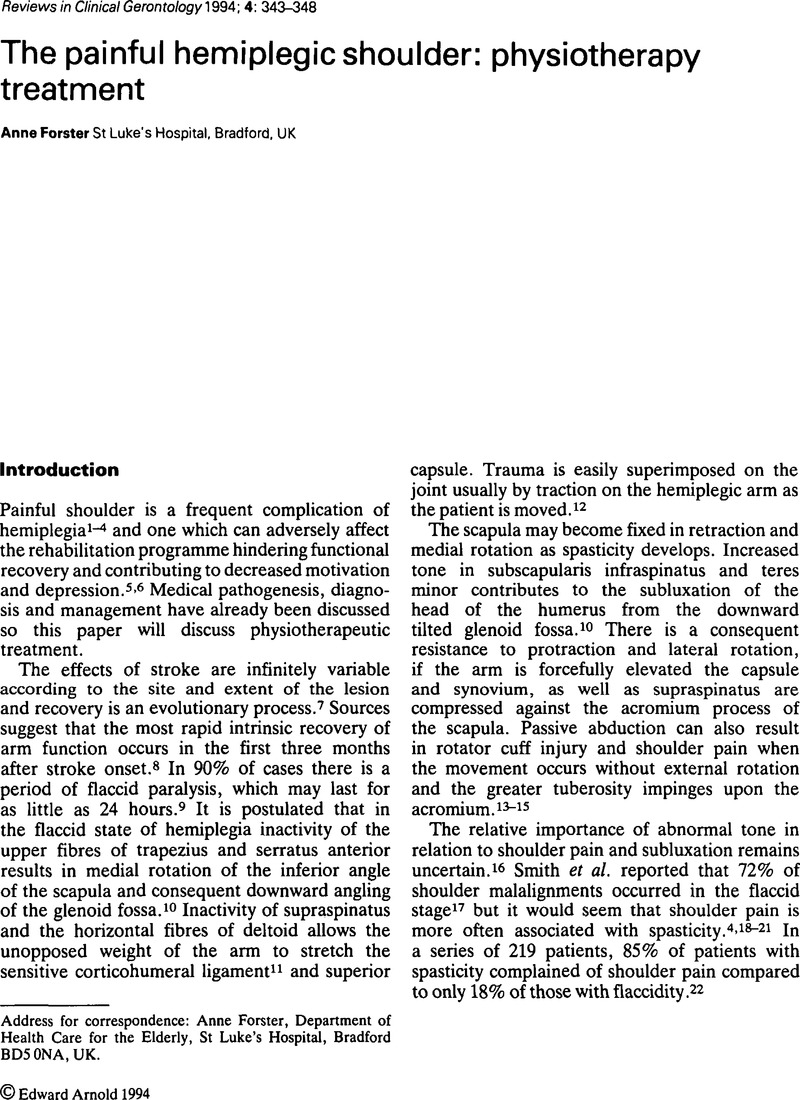Crossref Citations
This article has been cited by the following publications. This list is generated based on data provided by Crossref.
Price, Christopher I.M.
Franklin, Paul
Rodgers, Helen
Curless, Richard H.
and
Johnson, Garth R.
2000.
Active and passive scapulohumeral movement in healthy persons: A comparison.
Archives of Physical Medicine and Rehabilitation,
Vol. 81,
Issue. 1,
p.
28.
Hanger, H C
Whitewood, P
Brown, G
Ball, M C
Harper, J
Cox, R
and
Sainsbury, R
2000.
A randomized controlled trial of strapping to prevent post-stroke shoulder pain.
Clinical Rehabilitation,
Vol. 14,
Issue. 4,
p.
370.
Pomeroy, V M
Niven, D S
Barrow, S
and
Faragher, E B
2001.
Unpacking the black box of nursing and therapy practice for post-stroke shoulder pain: a precursor to evaluation.
Clinical Rehabilitation,
Vol. 15,
Issue. 1,
p.
67.
Tyson, S F
and
Chissim, C
2002.
The immediate effect of handling technique on range of movement in the hemiplegic shoulder.
Clinical Rehabilitation,
Vol. 16,
Issue. 2,
p.
137.
Turner-Stokes, Lynne
and
Jackson, Diana
2002.
Shoulder pain after stroke: a review of the evidence base to inform the development of an integrated care pathway.
Clinical Rehabilitation,
Vol. 16,
Issue. 3,
p.
276.
Aoyagi, Yoichiro
and
Tsubahara, Akio
2004.
Therapeutic Orthosis and Electrical Stimulation for Upper Extremity Hemiplegia After Stroke: A Review of Effectiveness Based on Evidence.
Topics in Stroke Rehabilitation,
Vol. 11,
Issue. 3,
p.
9.
Pizzi, Assunta
Carlucci, Giovanna
Falsini, Catuscia
Verdesca, Sonia
and
Grippo, Antonello
2005.
Evaluation of upper-limb spasticity after stroke: A clinical and neurophysiologic study.
Archives of Physical Medicine and Rehabilitation,
Vol. 86,
Issue. 3,
p.
410.
Namdari, Surena
and
Keenan, Mary Ann
2010.
Outcomes of the Biceps Suspension Procedure for Painful Inferior Glenohumeral Subluxation in Hemiplegic Patients.
The Journal of Bone and Joint Surgery-American Volume,
Vol. 92,
Issue. 15,
p.
2589.
Ramos-Valero, L.
and
Meseguer-Henarejos, A.B.
2013.
Tratamientos fisioterápicos para pacientes con hombro doloroso tras un accidente cerebrovascular. revisión sistemática.
Fisioterapia,
Vol. 35,
Issue. 5,
p.
214.
Cole, Andrew
and
Cox, Talitha
2019.
Treatment of Glenohumeral Subluxation.
American Journal of Physical Medicine & Rehabilitation,
Vol. 98,
Issue. 8,
p.
706.



